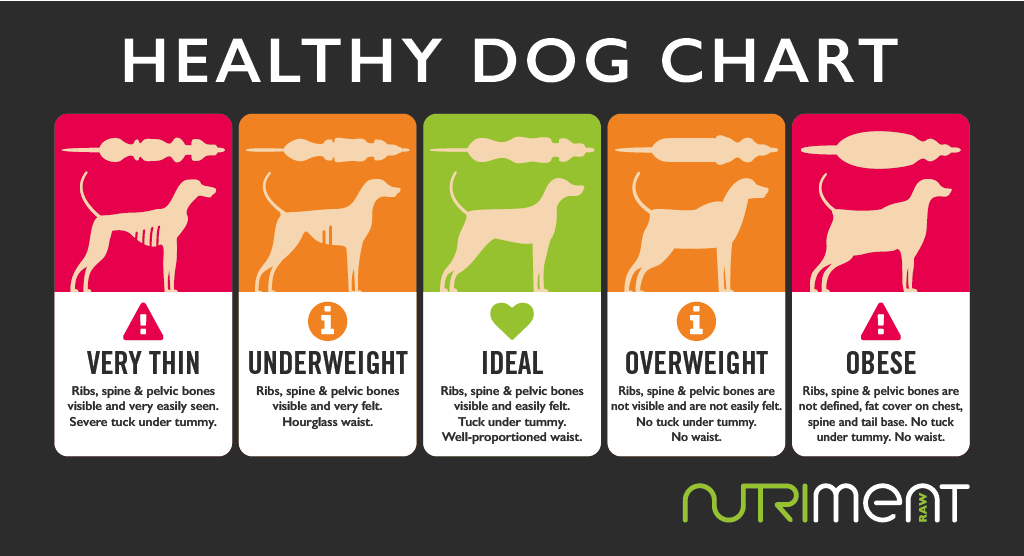Is Your Dog The Correct Weight?

At Nutriment, we suggest Body Scoring your dog, as a useful tool to determine your dog’s ideal weight.
How to Body Score your dog
Your dog should be stood square and on an even surface.

Step 1 – Feel the ribs.
Spread your hands across the ribs. Ribs should be felt easily with a small amount of pressure. Ribs that can be felt with no pressure indicate the dog is underweight. Ribs that are difficult to feel with harder pressure indicate a dog that is overweight.
Step 2 – Feel and observe the waist.
The waist should be smaller than the width of the rib cage and should increase again by the pelvic area. If the waist is narrow with no hourglass shape the dog may be underweight. If the waist is the same width as the last ribs then the dog is overweight.
Step 3 – Feel the base of the tail.
Feel for the hip bones and the spine in this area. The area should have a smooth contour but the bones can be felt with a small amount of pressure. Protruding spine and hip bones may indicate the dog is underweight. Where the hip bones are difficult to feel, even under harder pressure, the dog is overweight. Overweight dogs may also develop a roll of fat at the base of the tail that can give the appearance of a dimple.
What do I do if my dog is underweight?
Adult dogs, when fed a raw diet, typically need to be fed 2-3% of their ideal bodyweight per day to maintain a healthy weight. However, as all dogs are individual (different energy levels, exercise levels, metabolism rates etc) you may need to feed more (or less) to maintain proper weight.
Therefore, the first thing to consider is increasing the food intake. Even 0.5% of additional food can make a difference – after all the nutrients in a BARF diet are easily accessible by the body.
It is also worth reviewing which formulas you are feeding. Some dogs can benefit for those with a higher fat content to maintain a healthy weight:
Of course, we always advise speaking to your vet before making any changes to diet.
What do I do if my dog is overweight?
Just like above, a small change to the amount you are feeding can have a big impact on overall weight. Decreasing the amount of food can support maintaining a healthy weight. We are well aware that raw portions already look small in the bowl, so bulking the food with additional vegetables is a great way to make the portion larger, without adding any additional fats.
Opting for lower fat formulas can also support your dog’s journey to the ideal weight:
Other factors, such as treats and exercise, are covered in our handy blog, here.
If you think your dog could be overweight, speak to you vet to discuss your concerns and your dog’s diet before making any changes.
What else do I need to consider?
- Puppies naturally commonly carry a little more weight – this is good as they need the extra to account for growth spurts.
- Senior dogs tend to have a slower metabolism, which should be factored into the daily food intake.
- Reaching optimum weight should be gradual, there are no quick fixes, and it is better to go slow. Therefore, any changes should be gradual too.
- Always speak to your vet before making any change to diet or exercise.
- Our team of experts are available to help find the right products for your dog, depending on your dog’s goals and dietary requirements.








